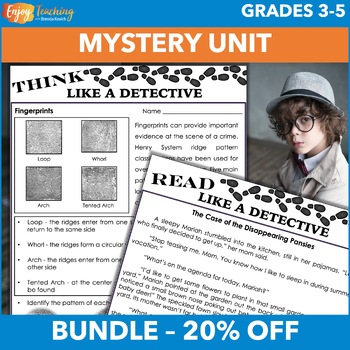Mystery Genre Study Unit - Read, Write & Think Like a Detective Activities
- Zip
- Internet Activities
- Easel Activity

What educators are saying
Products in this Bundle (10)
showing 1-5 of 10 products
Bonus
Description
Read, write, and think like a detective! Bulk up your mystery genre study with inference activities, short stories, writing projects, secret codes, observation, logic puzzles, fingerprinting, and invisible ink! This unit is guaranteed to engage your third, fourth, or fifth grade students.
Open the previews to take a closer look at all resources.
Eight inference activities and five short detective stories help kids build critical thinking and deduction skills. These literature materials are great additions to any genre study. The passages can also be used as stand-alone reading comprehension activities.
- Making Inferences - In order to understand mysteries, students must be able to pull subtle clues from the text and make inferences. For example, if a character’s eyes are red and puffy, kids can infer that he has been crying (or has allergies). Three read-aloud situations introduce inferences. Then kids complete five worksheets independently. Each focuses on a specific theme: professions, age groups, relationships, vacation spots, or information about people.
- Mystery Stories - Five short, simple original stories are included. Reading them helps students use close reading to locate subtle clues (including false clues, or red herrings). They can also act as exemplars for student writing. Each comes in two versions - with and without solutions at the end.
- Book Report - Kids use a template or create a puzzle piece project to explain a mystery story they read.
This set of activities was designed to let kids write their own mysteries. Choose from three fun projects: (1) crafty puzzle pictures, (2) choose-your-own-clues paper bag mysteries, or (3) a traditional mapped detective stories. The projects scaffold from simplest to most complex and can be used to differentiate writing in your classroom.
- Puzzle Pictures - This little activity is more craft than writing. It makes a great classroom display. Kids print or cut pictures of well-known objects, animals, or people. Then they write clues beneath the picture, cut a small viewing area, and staple the paper on top of the picture. Classmates can view a small piece of the picture, read the clues, and guess what it is. They can lift the paper to see if they’re right.
- Paper Bag Stories - To prepare for this activity, cut and fold three sets of cards: character, setting, and situation. Place each set in a labeled paper bag. Students pick one card from each bag, then develop a mystery around them.
- Mapped Detective Stories - Kids develop their own clues. First, they read and analyze “The Case of the Missing Cookies” (included). Then they use the planning sheets to organize, develop, and write their own stories.
Now add some fun to your unit! This set of activities lets kids explore how a detective thinks - and makes them do a little thinking of their own. Your students will love decoding secret messages, analyzing fingerprints, trying different types of invisible ink, playing observation games, and working logic puzzles.
- Secret Codes - Students are presented with five different codes. For each, they decipher an encoded message and write their own messages too. (An answer key is provided.)
- Observation - Try this set of six activities to see how observant your little detectives are.
- Deductive Reasoning - Let students work on their deductive reasoning skills with a set of five logic puzzles. For an extra challenge, have them make their own puzzle. (It’s easy if they write all checks and exes after they write each clue.)
- Fingerprints - Kids learn about the history of fingerprinting and patterns. Then they record and analyze their own fingerprints. Twelve cards let them try their hand at matching like fingerprints.
- Invisible Ink - After learning about the history and types of invisible ink, students try three kid-friendly methods. Then they determine which is most effective. As an extension, kids may send secret messages to their classmates.
- Room Transformation - In the bonus file, you'll find a poster, station signs, and detective badges that let you use these mystery activities for centers or a theme day.
You'll also receive a set of mystery genre resources to use with any book: poster, anchor chart, graphic organizer, vocabulary terms, and quiz.
Enjoy teaching!
Brenda Kovich





